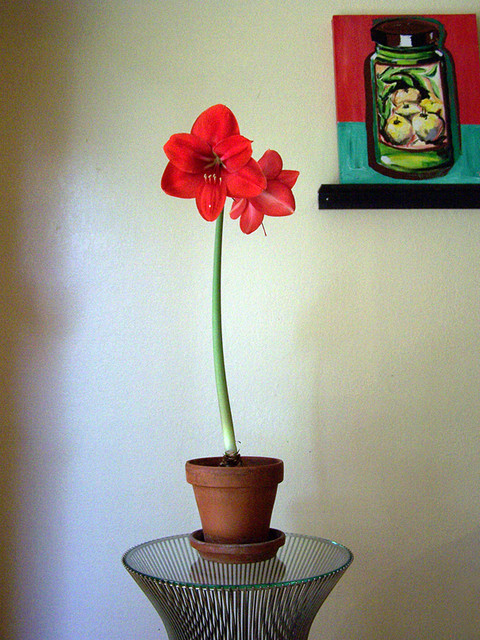Force Amaryllis bulbs to bloom by giving them a cold treatment for 8 to 10 weeks in a dark, dry location, then bring them into a warmer area with sunlight and regular watering. When the cold treatment is complete, place the bulbs in a pot with well-draining soil, leaving the neck exposed, and water them sparingly until growth emerges.

Credit: www.houzz.com
How to Force Amaryllis Bulbs to Bloom : Step by Step Guide
Choosing The Right Bulbs
Selecting the right amaryllis bulbs is crucial in promoting successful blooms. To ensure optimum results, pay attention to bulb size and quality. Look for bulbs that are large and firm, as these tend to produce the most vibrant and healthy flowers.
Avoid any bulbs that are soft or squishy, as they may be damaged or prone to disease. Additionally, choose bulbs that have a healthy green shoot emerging from the top. This indicates that the bulb is actively growing and likely to bloom well.
By following these guidelines, you will increase your chances of successfully forcing amaryllis bulbs to bloom and enjoy their beautiful flowers.
Preparing Bulbs For Forcing
To force amaryllis bulbs to bloom, it is crucial to prepare them correctly. Start by timing the planting process according to the desired blooming period. Pre-chill the bulbs in the refrigerator for 6-10 weeks to simulate winter conditions. This encourages flower formation.
Next, prepare and sterilize pots or containers to avoid any potential diseases. Choose a well-draining soil mix specifically formulated for bulbs and ensure it is thoroughly prepared. Avoid overwatering, as it can lead to rot. By following these steps and providing the bulbs with proper care, you can successfully force amaryllis bulbs to bloom and enjoy their beautiful flowers indoors.
Providing Optimal Growing Conditions
Providing optimal growing conditions for amaryllis bulbs is crucial for inducing blooming. Pay close attention to temperature and lighting requirements, as these factors greatly affect the plant’s growth. Maintain a temperature range of 65-75°F (18-24°C), ensuring the bulbs receive bright, indirect light for at least six hours daily.
Adequate watering is important, but make sure to avoid overwatering. Keep the soil slightly moist, but not soggy, and allow it to dry between waterings. Humidity levels should be moderate, around 40-60%. When it comes to fertilizing, apply a balanced liquid fertilizer once a month during the growing season.
Avoid using too much fertilizer, as it can result in foliage growth rather than flowers. By following these guidelines, you can successfully force amaryllis bulbs to bloom.
Promoting Healthy Growth
Promoting healthy growth requires effectively managing the growth cycle of amaryllis bulbs. Addressing common issues and challenges is vital for success. Pruning and providing support to the plant aids in its development. Ensuring proper air circulation is necessary to prevent diseases and encourage optimal growth.
By following these practices, you can create an environment that fosters blooming in your amaryllis bulbs.
Monitoring And Maintaining Bulbs
Monitoring and maintaining bulbs involves tracking their growth progress and adjusting conditions accordingly. By closely observing the bulbs, you can determine if they are developing as expected. If necessary, make changes in their environment to encourage proper blooming. Keep a careful watch for any signs of pests or diseases, as these can hinder the bulbs’ growth.
Regularly inspect the bulbs and take prompt action to prevent damage. Taking these measures will ensure that your amaryllis bulbs bloom beautifully.
Ensuring A Successful Bloom
Ensuring a successful bloom with amaryllis bulbs involves recognizing signs of bud development. Understanding the key indicators that your bulbs are ready to bloom is essential for encouraging flower bud formation. Look for the appearance of a thick stem emerging from the bulb, as well as the growth of green leaves.
Once these signs are present, it’s important to provide your bulbs with the optimal conditions to extend the blooming period. Keep them in a warm and well-lit area, and water them sparingly, allowing the soil to dry between waterings. Additionally, providing support such as stakes or trellises can help the tall stems remain upright as the flowers start to open.
By following these guidelines, you can successfully force your amaryllis bulbs to bloom and enjoy their vibrant and beautiful flowers.
Harvesting And Storing Flowers
To force amaryllis bulbs to bloom, it’s important to know how to harvest and store flowers effectively. Picking the perfect time to harvest is crucial. Once harvested, properly cutting and arranging the blooms is essential for optimal growth. Additionally, storing the bulbs for future use should be done correctly to ensure their longevity.
With careful attention to these steps, you can encourage your amaryllis bulbs to bloom successfully year after year. Proper care and maintenance are key factors in achieving vibrant and healthy flowers. So, make sure to follow these guidelines and enjoy the beauty of blooming amaryllis bulbs in your home or garden.
Troubleshooting Common Issues
A common issue when forcing amaryllis bulbs to bloom is leaf yellowing and discoloration. This can be caused by overwatering or inadequate drainage. To address this problem, adjust your watering schedule and ensure proper drainage for the bulbs. Another common problem is non-blooming or slow-blooming bulbs.
This could be due to insufficient light or improper temperature. To troubleshoot this issue, place the bulbs in a bright location with indirect sunlight and maintain a temperature of around 65-70 degrees Fahrenheit. Regularly fertilizing the bulbs with a balanced fertilizer can also help stimulate blooming.
Identifying and addressing these common problems can help you successfully force amaryllis bulbs to bloom and enjoy their vibrant flowers.
Frequently Asked Questions
Amaryllis bulbs can be forced to bloom outside their normal schedule by manipulating their growing conditions. Some frequently asked questions about this process include: When should I start forcing amaryllis bulbs? How can I stimulate bulb growth? How often should I water the bulbs?
Should I use a specific type of soil? Can I force amaryllis bulbs in water? Can forced bulbs be replanted after flowering? Let’s tackle each question one by one. To start forcing amaryllis bulbs, you should begin the process around 8 to 10 weeks before you want them to bloom.
In order to stimulate bulb growth, provide them with bright, indirect light and keep the temperature around 70°F. Water the bulbs sparingly, allowing the soil to dry between waterings. A well-draining potting mix is recommended for forcing amaryllis bulbs. While it is possible to force amaryllis bulbs in water, it is generally easier and more successful to force them in soil.
After they have bloomed, you can replant the bulbs in your garden or continue caring for them as houseplants.
Frequently Asked Questions Of How To Force Amaryllis Bulbs To Bloom
How Do You Stimulate An Amaryllis To Bloom?
To stimulate amaryllis blooming, provide bright indirect sunlight, water sparingly, and fertilize regularly.
How Do You Force Amaryllis To Bloom At Christmas?
To force amaryllis to bloom at Christmas, provide 12-14 weeks of dormancy by reducing watering and temperature.
When Should I Put Amaryllis In The Dark?
Put amaryllis in the dark when the leaves turn yellow and start to die back.
How Do You Wake Up An Amaryllis?
To wake up an amaryllis, place it in a bright room with indirect sunlight and water it regularly.
Conclusion
After following the steps outlined you should now be equipped with the knowledge to successfully force amaryllis bulbs to bloom. By providing the proper care and attention, such as choosing the right potting mix, providing adequate lighting, maintaining an optimal temperature, and managing the watering schedule, you can encourage your amaryllis bulbs to produce stunning blooms.
Remember to give them a period of dormancy to allow the bulbs to recharge and store energy for future blooms. Additionally, keep in mind that each amaryllis variety may require slightly different conditions, so it’s important to research specific care instructions for your particular bulbs.
With patience and a little TLC, you’ll be rewarded with beautiful, vibrant blooms that will brighten up your home or garden. Happy gardening!

